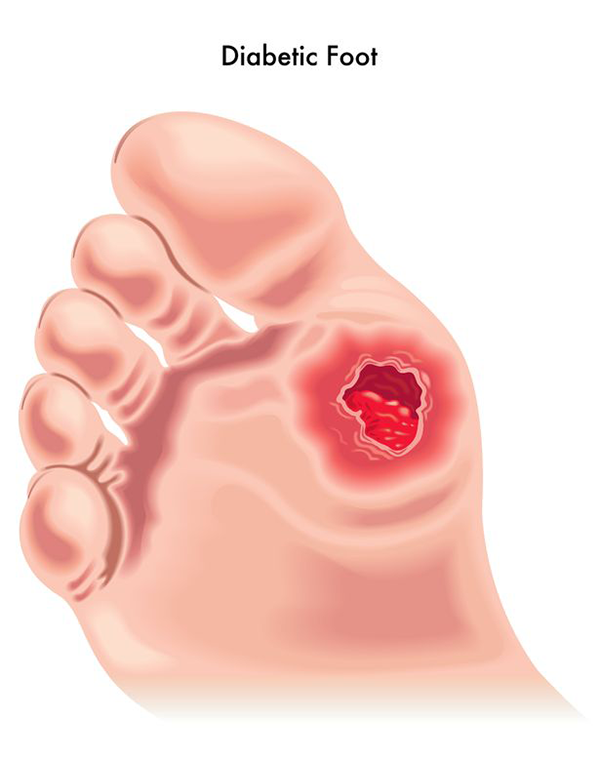
27 Jun The Dangers of Diabetes and Your Feet
Did you know San Antonio has one of the highest incidences of diabetes in the United States? According to the San Antonio Express News, 1,500 Bexar County residents lose a limb every year due to the disease – and many of these amputations could be prevented if people with diabetes paid attention to the warning signs.
First, why exactly are your feet affected by diabetes? Well, when you have diabetes, the circulation of blood to your feet isn’t ideal, making it more difficult for your body to fight infections and heal itself.
For example, when people without diabetes stub a toe or cut the bottom of their foot, in most cases, the foot will heal without medical attention. When a person with diabetes, on the other hand, cuts their foot, serious infections can occur, and without treatment, can cause gangrene, meaning your foot is dying.
In fact, diabetics are a whopping 20 times more likely to get gangrene in the foot than people without diabetes. And what’s even more alarming is because diabetes damages the nerve endings, you may not feel pain if you hurt your foot or develop an infection.
DIABETES SYMPTOMS OF THE FOOT
So, what exactly are the symptoms? Initial podiatric symptoms are swelling, redness or pain, and you may notice sores on the sole of your foot. While some may heal, most will return in the same place, and if the sores aren’t treated, that part of the skin on your foot may begin to die and turn black.
HOW DO YOU TREAT DIABETIC FOOT PROBLEMS?
If you notice swelling, redness or pain, immediately call your podiatrist. He or she may prescribe antibiotics to help fight infection, eliminate dead flesh and help new, healthy skin to grow. Additionally, your podiatrist may advise you to stay off your feet for a while to prevent further irritation. Worst case scenario is you may have to be hospitalized for treatment if antibiotics and other conservative treatments aren’t working. This could include removing the infected flesh surgically, or amputating all or part of your foot.
YIKES! SO HOW CAN I PREVENT DIABETIC FOOT COMPLICATIONS?
Check those feet every day and follow the diabetic foot care guidelines below. Remember, diabetics often don’t know they have cuts or scrapes on their feet due to slower circulation.
Bathe and Dry Your Feet Well
• Wash your feet every day with soap and warm (not hot) water. Then dry your feet carefully, especially between the toes. Apply lanolin after your feet are dry to keep the skin soft and free of scales.
• If your feet sweat a lot, keep them dry by dusting them with talcum powder.
Corns and Calluses
• Don’t treat corns or calluses yourself. Do not use over- the-counter products for these problems unless your health care provider says it is OK.
• Tell your health care provider right away if you develop a corn or callus.
Take Time With Your Toenails
• Cut your toenails carefully. Cut them straight across. Do not cut the sides or the cuticles.
• Clean your nails carefully.
• If your nails are hard to trim, ask your podiatrists office for help.
Keep Those Feet Warm!
• Wear cotton socks to bed if you need extra warmth for your feet.
• Avoid using hot water bottles or electric heaters to warm your feet. Because you may not fully sense hot and cold with your feet, you may burn your feet accidentally and develop an infection.
• Avoid putting your feet where they could accidentally be burned; for example, on hot sand at the beach, in hot bath water or whirlpools, or near a fireplace.
Your Shoes Matter
• Wear soft leather shoes that fit properly and have the seal of approval of the American Podiatric Medical Association.
• Ask your health care provider about specially made shoes, especially if you have foot problems.
• Avoid wearing new shoes for more than an hour a day until they are thoroughly broken in.
• Avoid sitting with your legs crossed.
• Wear clean socks and change them at least once a day.
So, if you’re one of the many Bexar County residents who are dealing with diabetes, make sure you don’t neglect those feet – you only have two! If you’re experiencing foot problems related to diabetes, call Strash Foot and Ankle Care. With more than 25 years experience, Dr. Walter “Wally” Strash thoroughly understands the foot complications often caused by diabetes.

